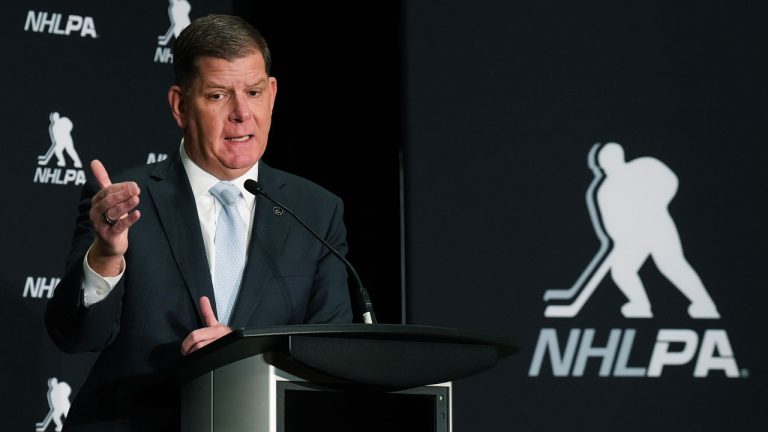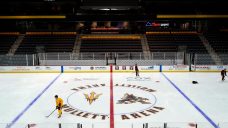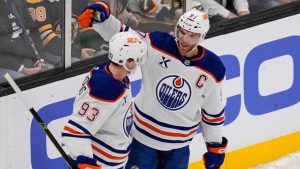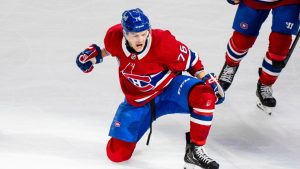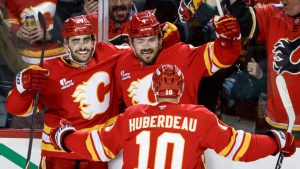TORONTO — A month ago, when the NHL’s board of governors convened in Manhattan to discuss the state of the league, talk of adding yet another seat at the table found its way onto the agenda once again.
Nothing is imminent, commissioner Gary Bettman had said then, but if the right offer comes the league’s way, they will listen. Salt Lake City appears a frontrunner in that conversation, Sportsnet’s Elliotte Friedman had reported, with Atlanta, Houston and Quebec City all seemingly in the mix, too.
But in NHLPA executive director Marty Walsh’s view, before any attention is paid to adding a 33rd or 34th franchise, the league must first clean up its mess in the desert.
“I think there are lots of rumours about two more expansion teams coming. I would say three expansion teams — the first one, really, is Arizona,” Walsh said Monday during a session at the PrimeTime Sports Management Conference, held at a harbourfront hotel in downtown Toronto. “They’re playing right now in a college arena, 5,100 fans that go to those games, and they don’t sell out. I think that’s the first thing we have to do — figure out what is the long-term play on Arizona.
“Those players are National Hockey League players. They deserve to play in a National Hockey League rink. So, hopefully we can do that. And that’s part of the business model too — you can’t have 31 teams playing in a full arena, and then one playing in a college arena, where you’re the second tenant, you’re not even the first tenant in that building.”
The Arizona Coyotes relocated to Arizona State University’s Mullett Arena starting with the 2022-23 season after their former rink — Glendale’s Gila River Arena, where the club resided for nearly two decades — cut ties with the franchise following the 2021-22 campaign. A dispute between the NHL club and the city of Glendale over tax delinquencies and unpaid rink charges preceded the ouster.
In February 2022, the Coyotes announced they would relocate to ASU’s 5,100-seat facility in Tempe for two seasons, with the option of remaining through 2025-26. Amid the criticism that followed, Bettman defended the move, and the Coyotes’ future in the desert. “You do what you have to do if you believe in a market long term,” he’d said.
Walsh, it seems, does not agree, a point he’s made before when asked about the Coyotes’ situation. What stands out now, beyond the general state of the franchise’s arena woes, he said, is the apparent lack of urgency from the Coyotes to find a long-term solution.
“I am [concerned]. I was hoping that would be further along right now, in what they’re going to do next,” the NHLPA boss told the media after his conference session had concluded Monday. “We met with them, I went there at the end of the season — they had promised they were going to work on some stuff. Right now, it’s just speculation. There’s nothing concrete. We’re at Nov. 12, the season’s moving quickly. … I’d love to see more action [there].
“I mean, these are NHL hockey players. They should be playing in a good arena. Come up with a plan — we said, ‘If you come up with a plan, we can support it.’ But right now, there’s been no plan, no conversation. So that, to me, is showing that there’s no urgency on their side.”
In wake of Pinto suspension, focus is on educating players about gambling risks
Still in the early days of his tenure as head of the NHLPA, Walsh has already seen more than a few novel situations cross his desk. At the top of that pile is the Shane Pinto ban, the Ottawa Senators forward suspended 41 games for violating the NHL’s gambling rules.
Given the lengthy penalty — Pinto’s suspension is among the longest in NHL history — for an offence that is still mostly under wraps, but is said to have not included Pinto personally wagering on NHL games, the question now is how the league and the NHLPA ensure players know where the line is.
“[Today’s players] have so many more pressures than any other generation," newly minted Senators owner Michael Andlauer said earlier this month, when asked about the Pinto situation. “You look at a young man who’s making millions of dollars and represents millions of people in a community, but he’s 21 years old, you know? Let’s say they’re injured and they’ve got time on their hands, and they’ve got millions of dollars and they’ve got a cellphone, and Wayne Gretzky gets on at MGM and talks about betting."
Currently partway through the NHLPA’s annual fall tour, which allows Walsh to spend time with players from each of the league’s 32 clubs, the NHLPA boss says the focus now is on laying out the rules as clearly as possible.
“I think the biggest thing there is just education, for the players — for everyone — about gambling. Just the concern of the addictiveness of gambling,” Walsh said Monday. “You know, a lot of these sites are popping up all over America and there are no rules or regulations around them. These players are held to a different standard, they’re under a spotlight — they could be a 22-year-old kid who plays hockey, or a 22-year-old kid who’s a construction worker, and the rules are different. So, it’s just explaining the rules.”
Conversation around neck guards in NHL to pick up in February
The hockey world was dealt a devastating blow late last month with the loss of former NHLer Adam Johnson, who died after having his neck cut by a skate. Following the Grand Rapids, Minn., native’s passing, conversations around the need for better neck protection have picked up around the sport.
Walsh confirmed that the NHLPA has been in discussions with the league to navigate the next steps toward potentially mandating neck guards, or at the very least presenting players with a viable option.
“The next morning, myself and Gary had a conversation about this,” Walsh said Monday. “They’re going to have some real conversations in Toronto during All-Star [weekend]. The issue with the neck guards is, there’s really no neck guard that’s been approved, completely, in the NHL at least. … Some of the players are trying out different material. But I think, hopefully, as we get towards February, there will be a better product on the market for our players.”
A number of NHL players have begun wearing different forms of neck protection in practice and in games. Washington Capitals veteran T.J. Oshie received over 100 text messages from players around the league after wearing a piece of cut-resistant neckwear made by his own company, Warroad Hockey, during a game earlier this month.
“We’re grown men. … You can make your own choices," Oshie told reporters after the game. "I made my choice for my kids. I want to stick around for them. I’m just trying to decrease the chance of injury.”
For Walsh, the NHLPA’s position on the issue is a simple one.
“I said this when I was the president of my laborer's union, and I say it now as the head of the PA. Our responsibility is that our players, our workers, go home after work,” he said Monday. “And that young man last week didn’t go home after work, after his game. His family didn’t have him come to their front door again.
“So, we have to make sure we’re protecting our players. But we also have to work with our players to make sure they’re good with what we’re doing.”
